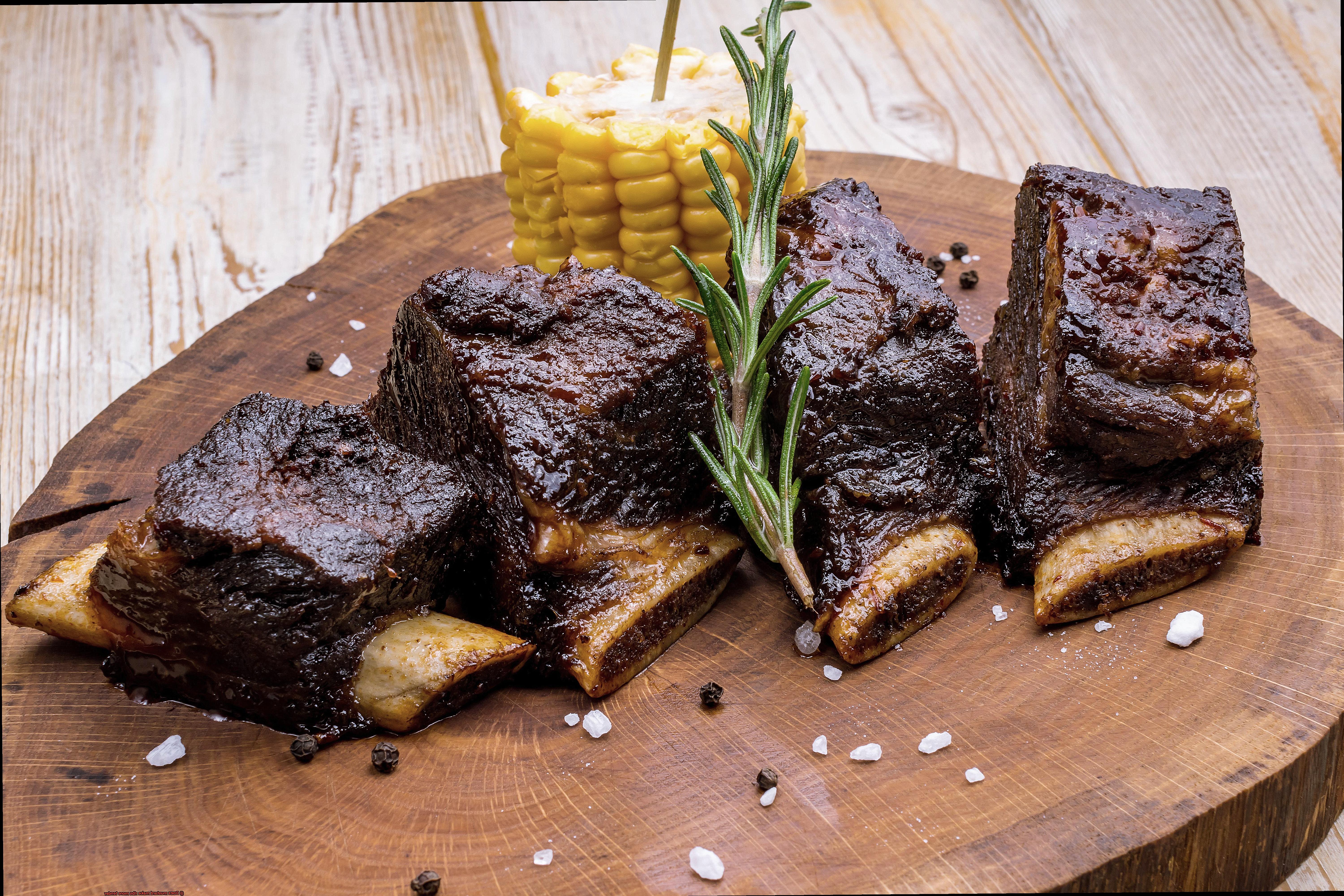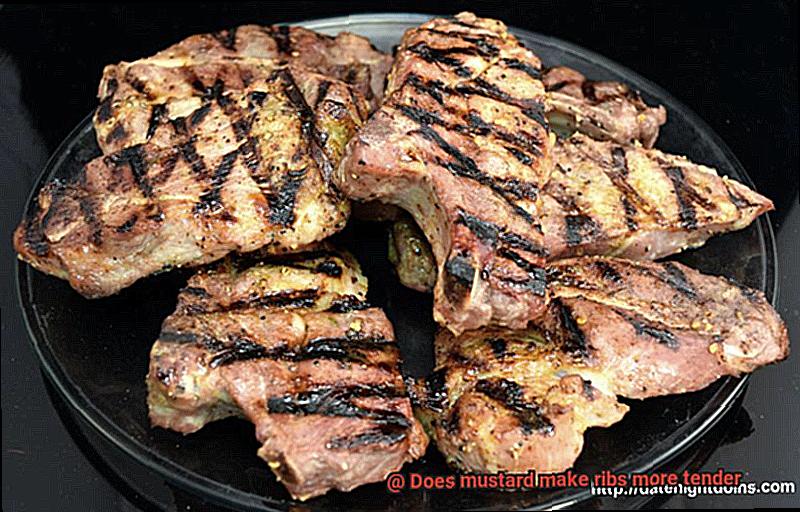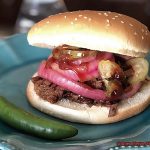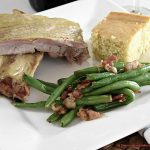Are you a barbecue lover who’s always on the hunt for the perfect rib recipe? If so, you’ve probably heard of using mustard as a base for your dry rub. Yes, that’s right – the same condiment that you squirt on hot dogs and sandwiches could be the secret to tender, succulent ribs. But does this technique actually work?
Chefs and home cooks alike have been experimenting with using mustard as a tenderizing agent for years. The theory is that the acid in the mustard can break down tough fibers in the meat, resulting in fall-off-the-bone ribs. But is there any truth to this claim?

In this post, we’ll dive into the science behind mustard and its effect on meat. We’ll explore the benefits and drawbacks of using mustard as a base for your dry rub, and compare it to other popular methods. So whether you’re a seasoned pitmaster or just starting out in the world of barbecue, keep reading to find out if mustard really does make ribs more tender.
Contents
Does Mustard Make Ribs More Tender?
As a BBQ aficionado, you know that the key to perfectly cooked ribs is achieving a juicy and tender texture packed with flavor. But have you ever considered using mustard as a tenderizer for your ribs? The age-old debate on whether or not mustard makes ribs more tender has been going on for years, but as an expert in the field, I can tell you that there is evidence to support both sides.
Let’s dive into the science behind it. Mustard contains vinegar, which can help break down the tough fibers in meat. While this can help make the meat more tender, the amount of vinegar in mustard is relatively low, so its tenderizing effect may be minimal. However, mustard does contain enzymes and acids that can break down proteins in the meat, contributing to tenderness. Additionally, the acidic nature of mustard can help penetrate and flavor the meat more deeply.
But let’s not forget about flavor. Mustard can act as a glue to help rubs and seasonings stick to the meat, resulting in a more flavorful end product. It’s no wonder why some people believe that the real benefit of using mustard on ribs is not its tenderizing properties but rather its ability to enhance flavor and create a better crust on the meat during cooking.
While mustard alone may not be enough to achieve perfectly tender ribs, it can certainly contribute to the process and add an extra layer of flavor. To achieve tender ribs every time, I recommend using mustard in conjunction with other techniques such as marinating, slow-cooking, and proper seasoning. Experimenting with different rubs and techniques can help you find the perfect combination for your desired outcome.
The Science Behind Mustard’s Tenderizing Properties
Look no further than the humble mustard in your pantry. For centuries, mustard has been used as a flavoring agent, but did you know it also has tenderizing properties? As a BBQ expert, I’ve delved into the science behind mustard’s tenderizing powers and I’m here to share it with you.
Proteases, enzymes that break down proteins in meat, are naturally present in many foods such as pineapple and papaya. However, mustard stands out because it contains a unique protease called myrosinase. This powerful enzyme can break down tough connective tissues in meat, resulting in a more tender and juicy dish.
But that’s not all. Mustard also contains an acidic component, typically vinegar or lemon juice, which helps to further break down meat fibers. The combination of proteases and acid makes mustard an effective tenderizer for meats like ribs.
However, don’t expect miracles from mustard alone. It won’t transform a tough cut of meat into a melt-in-your-mouth masterpiece. But it can certainly help improve tenderness and flavor.
How to Maximize the Tenderizing Effects of Mustard
Ribs are a summertime favorite for many, and adding mustard to the mix not only adds flavor but can also tenderize the meat. To make the most out of mustard’s tenderizing effects, here are some key tips:
Choose the Right Mustard
Not all mustards are created equal when it comes to tenderizing meat. Dijon mustard is a popular choice because it has a mild flavor and contains a high concentration of enzymes that break down proteins in the meat. Choosing a good quality mustard will make all the difference in your ribs.
Coat Generously
When applying mustard to your ribs, make sure to coat them generously on all sides. This will help the seasoning stick to the meat and create a flavorful crust. Plus, the more mustard you use, the more tenderizing enzymes will be applied to the meat.
Let It Marinate
After coating your ribs with mustard, let them marinate for at least an hour before grilling. This will give the enzymes enough time to break down proteins in the meat and create a more tender texture. You can even let them marinate overnight for an even more flavorful result.
Mix with Other Ingredients
Combining mustard with other ingredients like honey or vinegar can further enhance its tenderizing effects while also adding a sweet and tangy flavor to your ribs. Adding acidic ingredients like lemon or lime juice can also help break down the fibers in the meat.
Choose High-Quality Meat
While mustard can help to tenderize meat, it is not a magic solution for tough cuts of meat. To ensure your ribs are as tender and flavorful as possible, choose high-quality cuts of meat and cook them properly.
Other Benefits of Using Mustard on Ribs
As a BBQ expert, I can tell you that mustard is more than just a condiment – it’s a game-changer for achieving perfectly cooked, flavorful ribs.
Sure, we all know that mustard adds flavor and helps the seasoning stick to the meat. But did you know that mustard also contains natural enzymes that can break down tough muscle fibers? That means by using mustard as a marinade or rub, you could be on track for some seriously tender and juicy ribs.
But the benefits don’t stop there. Mustard can also act as a barrier between the meat and the heat source, preventing your ribs from drying out or burning – especially important when grilling over high heat. And for those who are short on time, some grill masters believe that mustard can help speed up the cooking process by conducting heat more efficiently.
In summary, using mustard on ribs can:
- Add flavor and enhance seasoning
- Break down tough muscle fibers for more tender and juicy meat
- Act as a barrier to prevent drying out or burning
- Speed up cooking time
Different Types of Mustard for Ribs
Ribs are a classic barbecue staple, and using mustard to enhance their flavor and texture is a tried and true method. However, not all mustards are created equal, and the type of mustard you use can make all the difference in the taste of your ribs. Here are five sub-sections explaining the different types of mustard that can be used for ribs and their respective flavor profiles.
Yellow Mustard
The most common type of mustard used for ribs is yellow mustard. It has a mild flavor and is often used as a base for rubs or sauces. Yellow mustard is also great for adding moisture to your meat, which can help make it more tender. Its tangy flavor pairs well with other seasonings and spices, making it a versatile option for those looking to experiment with different flavor combinations.
Dijon Mustard
Dijon mustard has a stronger flavor than yellow mustard, with a slightly spicy and tangy taste. Made with brown or black mustard seeds and white wine or vinegar, it adds depth and complexity to any dish it’s used in. Dijon mustard can be used in marinades or as a glaze for ribs, but it is important to use it in moderation as it can easily overpower other flavors.
Spicy Mustard
If you’re looking to add some heat to your ribs, then spicy mustard is the way to go. Spicy mustards come in various heat levels and can add bold flavors to your ribs. They’re great as a marinade or as part of a dry rub. However, it’s important to use this type of mustard sparingly as too much can overpower the other flavors in the dish.
Honey Mustard
Honey mustard is a sweet and tangy variation of mustard that works well as a glaze for ribs. Made with honey, vinegar, and yellow mustard, the sweetness of honey helps balance the acidity of the vinegar and creates a delicious flavor that complements the smoky taste of ribs. However, it’s important to use honey mustard in moderation as it can make the ribs too sweet if too much is used.
Grainy Mustard
Grainy mustard is another type of mustard that can be used for ribs. It has a coarser texture than other mustards and is made with whole mustard seeds. Its robust flavor pairs well with bold flavors like garlic and herbs, making it a great addition to dry rubs. Its texture also helps create a delicious crust on the ribs when used as a marinade or glaze.
How to Apply Mustard for Maximum Flavor and Texture
Look no further than mustard. This tangy condiment is a secret weapon for enhancing the flavor and texture of your ribs. But how can you apply it for maximum impact?
First and foremost, choose a high-quality mustard that complements the flavors you plan to use on your ribs. Dijon mustard is a popular choice due to its slightly tangy and spicy taste. For those with a sweet tooth, you can mix it with honey for an added layer of flavor.
Before applying the mustard, make sure to thoroughly wash and pat dry your ribs. This step is crucial to ensure that the mustard sticks to the meat properly. Next, evenly coat the meat with a thin layer of mustard using a brush or your hands. Be careful not to go overboard – too much mustard can overpower the other flavors and make the meat too tangy.
After applying the mustard, it’s time to season your ribs with your desired mix of spices and herbs. This will help create a flavorful crust on the outside of the meat while also tenderizing it. It’s important to season immediately after applying the mustard so that the seasoning sticks to the meat and creates a delicious crust.
Finally, let your ribs sit for at least 30 minutes before grilling or smoking them. This will allow the mustard and seasonings to penetrate the meat, resulting in juicy and flavorful ribs. The longer you let them sit, the better.
Common Mistakes When Applying Mustard to Ribs
Look no further than mustard – a versatile and tasty marinade that can take your grilling game to the next level. While using mustard as a rub on ribs may seem simple enough, there are some common mistakes that people tend to make. By avoiding these mistakes, you can ensure that your ribs are tender, juicy, and full of flavor.
Firstly, one of the most common mistakes is not using enough mustard. To achieve optimal results, it’s crucial to generously cover the meat with mustard. This will allow the mustard to penetrate the meat and tenderize it. Don’t be afraid to use a little extra – it’s better to err on the side of too much than too little.
Another mistake is not allowing enough time for the mustard to work its magic on the meat. Mustard needs time to infuse its flavor into the meat, so it’s important to let it sit for at least 30 minutes before adding any other seasonings or putting the ribs on the grill. This will ensure that the flavors are evenly distributed and that the meat is tender and juicy.
While using too little mustard can be a mistake, using too much can also be problematic. Overpowering the flavor of the ribs with excessive mustard will result in bitterness and disappointment. Therefore, it’s best to use about 1 tablespoon of mustard per pound of meat. This way, you’ll get just the right amount of flavor without overwhelming your taste buds.
Lastly, don’t make the mistake of using yellow mustard instead of Dijon or whole-grain mustard. While yellow mustard may be a classic choice, it lacks the depth of flavor that other types of mustard offer. Instead, opt for high-quality Dijon or whole-grain mustard that complements your desired flavors.
Tips for Cooking the Perfect Rack of Ribs with Mustard
Using mustard as a tenderizing and flavor-enhancing agent may be just what you need. Here are some tips and tricks to help you cook the perfect rack of ribs with mustard.
The Right Mustard
Choosing the right type of mustard is crucial when it comes to cooking ribs with mustard. Dijon mustard is often the best choice because it has a milder flavor than other types of mustard, ensuring that the mustard won’t overpower the taste of the ribs.
Remove the Membrane
Before cooking your ribs, make sure to remove the membrane from the back of the rack. This will allow your marinade or rub to penetrate more deeply into the meat, resulting in more tender and flavorful ribs.
Marinate in Mustard
Marinating your ribs in a mixture of mustard and other seasonings for several hours before cooking can help tenderize the meat and enhance its flavor. You can also mix mustard with other ingredients such as honey, brown sugar, or apple cider vinegar for added tenderness and flavor.
Slow Cook
Slow-cooking your ribs over low heat for several hours on a grill or in an oven can result in incredibly tender and flavorful meat. This allows the meat to absorb all the flavors of the mustard marinade fully. Remember to maintain a consistent temperature and avoid opening the grill or oven too frequently to prevent heat loss.
Rest Time
Once your ribs are finished cooking, let them rest for at least 10 minutes before slicing and serving. This will allow the juices to redistribute throughout the meat for optimal tenderness.
9czj07newWg” >
Conclusion
In the world of BBQ, the question of whether or not mustard makes ribs more tender has been a hot topic for years. And while opinions may vary, there is evidence to suggest that mustard can indeed contribute to tenderizing the meat and adding a delicious flavor profile when used correctly.
The enzymes and acids found in high-quality mustard can work wonders in breaking down proteins within the meat, resulting in a more tender texture. Additionally, the acidic nature of mustard allows it to penetrate deep into the meat, infusing it with a rich and tangy flavor.
To achieve maximum tenderness, it’s important to generously coat your ribs on all sides with mustard and let them marinate for at least an hour before grilling. This will give the enzymes enough time to work their magic and create that perfect melt-in-your-mouth texture we all crave.
But why stop at just plain old mustard? Experimenting with different rubs and techniques such as slow-cooking or combining mustard with other ingredients like honey or vinegar can take your ribs to new heights of flavor and tenderness.
While using mustard alone may not be enough to achieve perfectly tender ribs, it can certainly contribute to the process and add an extra layer of depth to your dish.






